Plagiarism in the thesis can cause a lot of issues. So, how do you detect it?
Plagiarism is the deliberate act of taking someone else’s work and passing it off as your own. This severe offense can lead to expulsion from school, termination of employment, or even lawsuits. Studies show that this practice begins early, as 4 out of 5 high schoolers admitted to plagiarizing.
This doesn’t only tell us the frequency of plagiarism but also the recurrence of it at various academic levels. Therefore, it’s imperative to not only tackle this problem at the root but also to understand it. That’s why today we’ll be analyzing:
- Definition of plagiarism and its impact on thesis
- Four main types of plagiarism
- How to detect plagiarism
So, let’s begin.
Defining Plagiarism and Its Impact on Thesis
Plagiarism is the act of using someone else’s words or ideas without giving credit to the original author. Some people see plagiarism as the act of stealing someone else’s words, thoughts, or ideas and passing them off as your own. It’s unethical and wrong. This can be done in a number of ways, including:
- Copying passages from another work and presenting them as your own
- Without quotation marks
- Paraphrasing someone else’s work by changing words but not giving them credit for their ideas
- Or claiming that your own work is original when it includes words or ideas from another person
The word plagiarism comes from the Latin word “plagiarius,” meaning kidnapper or pirate. The word was first used in English around 1606 to refer to people who stole and sold other people’s writings as their own.
It is important to note that plagiarism is not the same as copyright infringement. Plagiarism means using someone else’s work and presenting it as your own. Copyright infringement means using someone else’s work without their permission.
But, even unintentionally copying or duplicating someone else’s work without giving credit to the original source is still plagiarism. This includes summarizing an article without giving credit to the original author.
Therefore, in thesis and research, it’s even more important to understand the importance of sourcing, quoting, and citing. It’ll help avoid not only plagiarism but also ensure the overall integrity of the research and thesis.
Primary Plagiarism Types
To avoid plagiarism effectively, you must understand the most common types of plagiarism. This will help you ensure that you detect them correctly. Here are the four main plagiarism types:
In the case of total/complete plagiarism, a writer will copy another person’s work word-for-word.
And then present it as their own without giving credit to the original author. Since this is such an easy thing to do, many writers are tempted to do so because it saves them time and effort.
However, this can lead to severe consequences for the writer if they are caught doing so. The most common consequence of total/complete plagiarism is getting a thesis rejected or failing grades.
Direct plagiarism is the act of taking someone else’s work and passing it off as your own. Direct plagiarism is a serious offense that can result in being expelled from school, fired from a job, or even sued.
It is a common misconception that plagiarism only happens if you submit someone else’s work as your own. Plagiarism can happen even if you are not trying to deceive anyone. This type of plagiarism is called unintentional plagiarism or accidental plagiarism.
Patchwork plagiarism is a term used to describe the act of plagiarizing from multiple sources. It’s done in a way that does not make it evident that the content has been taken from different sources.
Patchwork plagiarism is one of the most common types of academic fraud. It can be easily detected by plagiarism detection tools.
Step Guide to Find Plagiarism Using a Plagiarism Checker
Finding plagiarism is a straightforward process if you know how to look. Suppose you’ve spent countless hours writing a research paper or thesis. In that case, it’s imperative that you take another 10 minutes and follow this 6-step guide to find plagiarism:
1. Find A Plagiarism Checker
The first step you’ll take is finding a plagiarism checker. Anything that’s free and offers something that helps you search your thesis for duplicity.
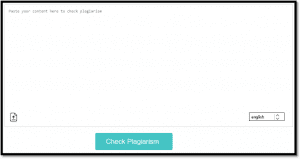
Therefore, look for things such as:
- 500–1000-word limit
- Language support
- Percentage of plagiarism
- Source location
Once done, move on to the next step.
2. Upload Your Text
The next thing you’ll do is upload your text. For that, you’ll have to find the upload button so you can upload your text files, such as DOCX. So, look for an option like this:

Or, you can simply copy all the content that you wish to scan for plagiarism, like this:
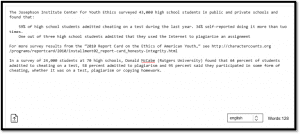 You can also go with the second option to find plagiarism in only the suspected bit. Because, many times, the entire content scan can take time. So, scanning only a few paragraphs might be better.
You can also go with the second option to find plagiarism in only the suspected bit. Because, many times, the entire content scan can take time. So, scanning only a few paragraphs might be better.
3. Pick The Language
The next step will require you to check the language and see that it matches your thesis. Why is this important? There are a few reasons behind it.
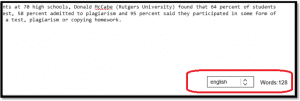 Reasons such as:
Reasons such as:
- It allows plagiarism checker to find websites with the adequate language
- It ensures thorough results
- It ensures quick scanning
While by default, the language will be set to English, you can change it to others if your thesis is in another language.
4. Check For Plagiarism
The next thing you’ll do is check for plagiarism. This step will require you to do a little captcha check. Once you’re done, here’s what you’ll see in most capable plagiarism finders:

Once the progress bar finishes up, you’ll see the results. However, this process rarely takes around 5-10 seconds for words fewer than five hundred.
5. Analyze The Percentage
This is the step where you understand how much of your content is plagiarized. Since we took this text from another website, the chances of the tool finding plagiarism in it were very high. So, the tool proves itself capable and shows us this percentage:

As a writer, this is something you do not want to see. That’s why you need to aim for more green than red.
6. Find The Source
The next and final step of checking plagiarism is to find the source and copy it for citation. Upon scrolling down further, you will find the source of plagiarism. Meaning the link where the original content was posted, so you can quote it.
Here’s how:
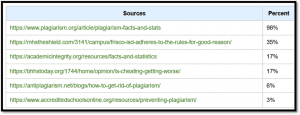
As you can see, this text matches 98% of the one posted on Plagiarism.org. Therefore, it’s highly likely the other sources copied or cited it as the primary source. So, pick the one that matches your text the most by comparing them:
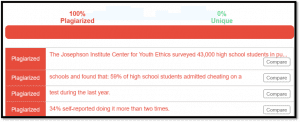
Once done, you’ll know where exactly plagiarism is in your text and the source from where it originated.
Suggested Tool to Check for Plagiarism
Throughout the demonstration, we used Editpad’s plagiarism checker. This outstanding plagiarism finder allows you to scan up to thousand words at a time. And, you can pick from 16 languages, so you don’t have to worry about writing a thesis in any language.
On top of that, it helps us:
- Analyze the percentage
- Find the source
- Compare the text
Therefore, checking for plagiarism in your thesis is our suggested choice.
Conclusion
These factors of checking plagiarism help you stand out in writing a thesis. Not only did we analyze the various plagiarism types you need to look out for, but also how you can scan for them using a professional tool.














